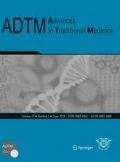Abstract
Plants contain a wide range of phytochemical constituents and therefore, are used in the pharmaceutical industry either indirectly or directly. Citrus pseudolimon is an important medicinal plant of the family Rutaceae and, had not been previously explored for any beneficial effect. The main objective of the study was to perform the phytochemical quantitative analysis and demonstrate the antimicrobial activity of Citrus pseudolimon peel and juice. The results thus, obtained with respect to the quantitative phytochemical analysis was recorded with higher total carbohydrates, proteins, phenolics, flavonoids, and tannin contents in the peel of Citrus pseudolimon when compared to its juice content. The quantitative phytochemical screening demonstrates that flavonoid content was higher in peel (5.47 mg/100 mg) than in juice (2.67 mg/100 ml), followed by the phenolic content which was little higher in peel (5.58 mg/100 mg) compared to that reported (0.34 mg/100 ml) in juice content respectively. Similarly, the tannin content was found to be higher in peel (35.70 mg/100 mg) than in juice (14.15 mg/100 ml). Furthermore, the tannin content in Citrus pseudolimon was found higher than phenolic and flavonoid content. However, in antimicrobial analysis, juice revealed stronger activity against gram-negative bacteria Escherichia coli zone (24 mm) than gram-positive bacteria Staphylococcus aureus (18 mm) while no activity was shown by peel against both these bacterial strains. It can be concluded that the peels revealed high phytochemical content, while juice fraction was recorded with strong antibacterial activity.






References
Beattie GA, Holford P, Mabberley DJ, Haigh AM, Bayer R, Broadbent P (2008) Origins of Citrus, huanglongbing and the Asiatic citrus psyllid. In Proceedings of the sixth Việtnam conference on entomology, pp 9–10
Block G, Patterson B, Subar A (1992) Fruit, vegetables, and cancer prevention: a review of the epidemiological evidence. Nutr Cancer 18(1):1–29
Centers for Disease Control and Prevention (1992) Recommendations for the use of folic acid to reduce the number of cases of spina bifida and other neural tube defects. In: Morbidity and mortality weekly report (MMWR), vol 41, pp 1–7
Duarte O, Paull R (2015) Exotic fruits and nuts of the new world. CAB I:30
Fleming DJ, Jacques PF, Dallal GE, Tucker KL, Wilson PW, Wood RJ (1998) Dietary determinants of iron stores in a free-living elderly population: the Framingham Heart Study. Am J Clin Nutr 67(4):722–733
Harats D, Chevion S, Nahir M, Norman Y, Sagee O, Berry EM (1998) Citrus fruit supplementation reduces lipoprotein oxidation in young men ingesting a diet high in saturated fat: presumptive evidence for an interaction between vitamins C and E in vivo. Am J Clin Nutr 67(2):240–245
Hatch GE (1995) Asthma, inhaled oxidants, and dietary antioxidants. Am J Clin Nutr 61(3):625S-630S
Kim DO, Jeong SW, Lee CY (2003) Antioxidant capacity of phenolic phytochemicals from various cultivars of plums. Food Chem 81:321–326
Lacey K, Hancock N, Ramsey H (2009) Measuring internal maturity of citrus. Department of agriculture and food farm note, ISSN 0726 – 934X: 1_4
Lowry OH, Rosebrough NJ, Farr AL, Randall RJ (1951) Protein measurement with the Folin Phenol reagent. J Biol Chem 193:265–275
Marjorie C (1996) Plant products as antimicrobial agents. Clin Microbiol Rev 12:564–582
Nascimento GG, Locatelli J, Freitas PC, Silva GL (2000) Antibacterial activity of plant extracts and phytochemicals on antibiotic-resistant bacteria. Braz J Microbiol 31(4):247–256
Okwu DE (2008) Citrus fruits: A rich source of phytochemicals and their roles in human health. Int J Chem Sci 6(2):451–471
Panda SO, Bandyopadhyay PK (2013) Chemical information from GCMS studies of methanolic leaf extract of Andrographis paniculata and Datura metel and their antibacterial activity against isolated Pseudomonas aeruginosa (pb112) strain. Int J Pharma Bio Sci 4(1):909–915
Spiegel-Roy P, Goldschmidt EE (1996) The biology of citrus. Cambridge University Press, Cambridge, p 28
Tamilselvi N, Krishnamoorthy P, Dhamotharan R, Arumugam P, Sagadevan E (2012) Analysis of total phenols, total tannins, and screening of phytocomponents in Indigofera aspalathoides (Shivanar vembu) Vahl EXDC. J Chem Pharma Res 4(6):3259–3262
Whitney EN, Rolfes SR (1999) Understanding Nutrition, 8th edn. West/Wadsworth, Belmont
Xu HR, Ye ZZ, Ying YB (2005) Identification of citrus fruit in a tree canopy using color information. Trans Chin Soc Agric Eng 21(5):98–101
Zhishen J, Mengcheng T, Jianming W (1999) The determination of flavonoid contents in mulberry and their scavenging effects on superoxide radicals. Food Chem 64:555–559
Acknowledgements
Authors are thankful to Hon'ble Vice-Chancellor, Shoolini University of Biotechnology and Management Sciences for providing necessary facilities.
Funding
None.
Author information
Authors and Affiliations
Corresponding author
Ethics declarations
Conflict of interest
Nitika Thakur has no conflict of interest, Swati Kumari has no conflict of interest.
Human and Animal participants
None.
Additional information
Publisher's Note
Springer Nature remains neutral with regard to jurisdictional claims in published maps and institutional affiliations.
Rights and permissions
About this article
Cite this article
Thakur, N., Kumari, S. Preliminary screening of phytochemicals and antimicrobial activity of Citrus pseudolimon. ADV TRADIT MED (ADTM) 22, 425–435 (2022). https://doi.org/10.1007/s13596-021-00561-y
Received:
Accepted:
Published:
Issue Date:
DOI: https://doi.org/10.1007/s13596-021-00561-y

